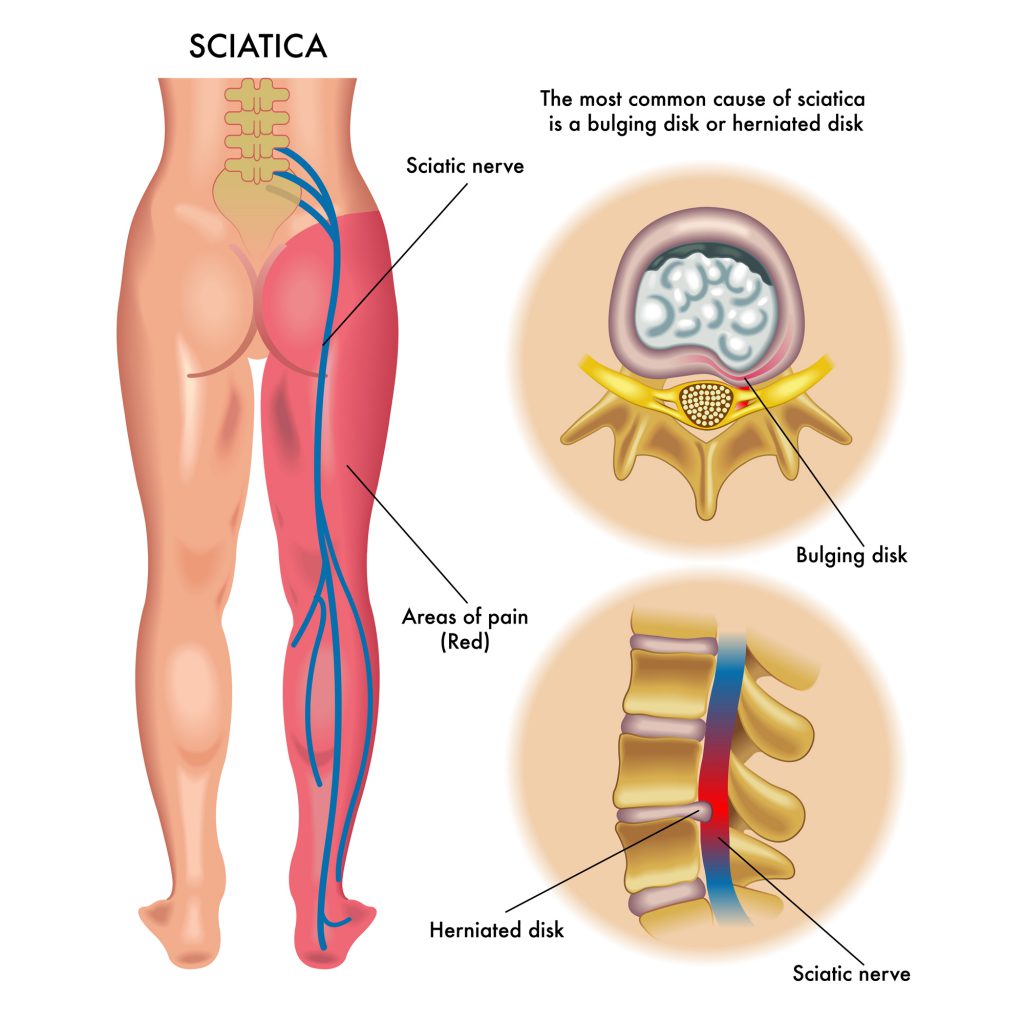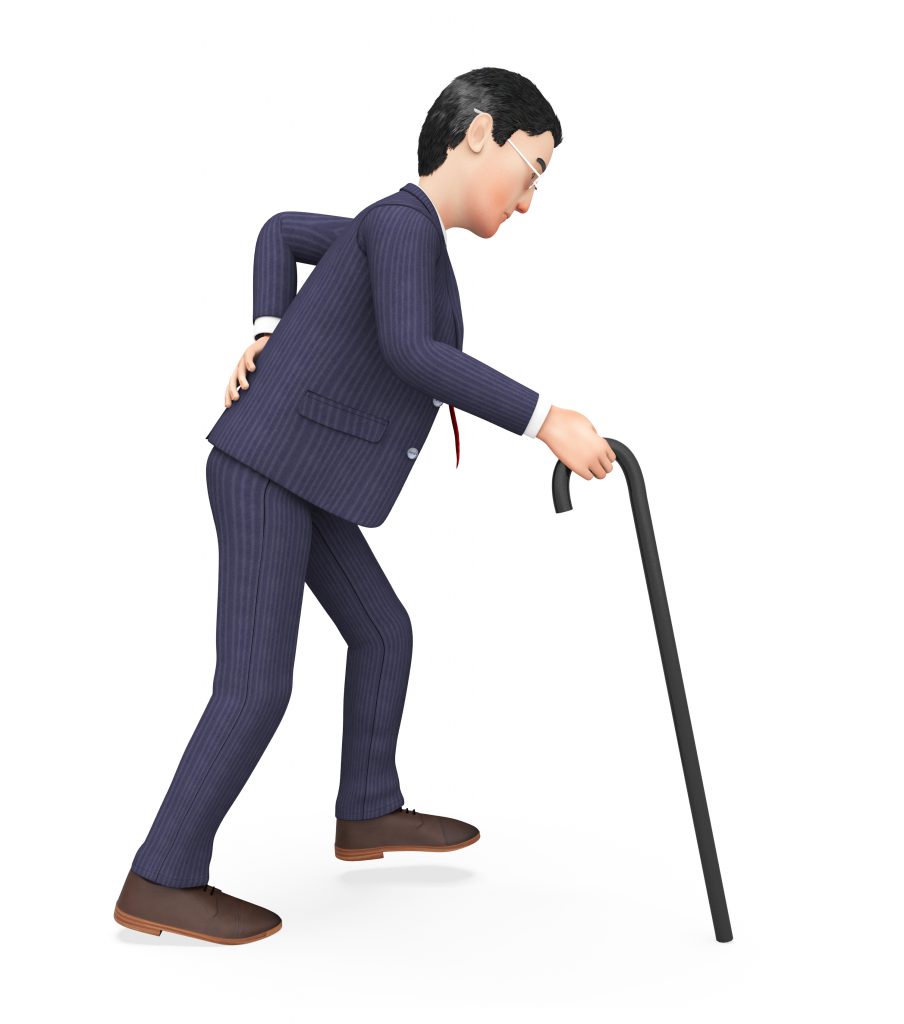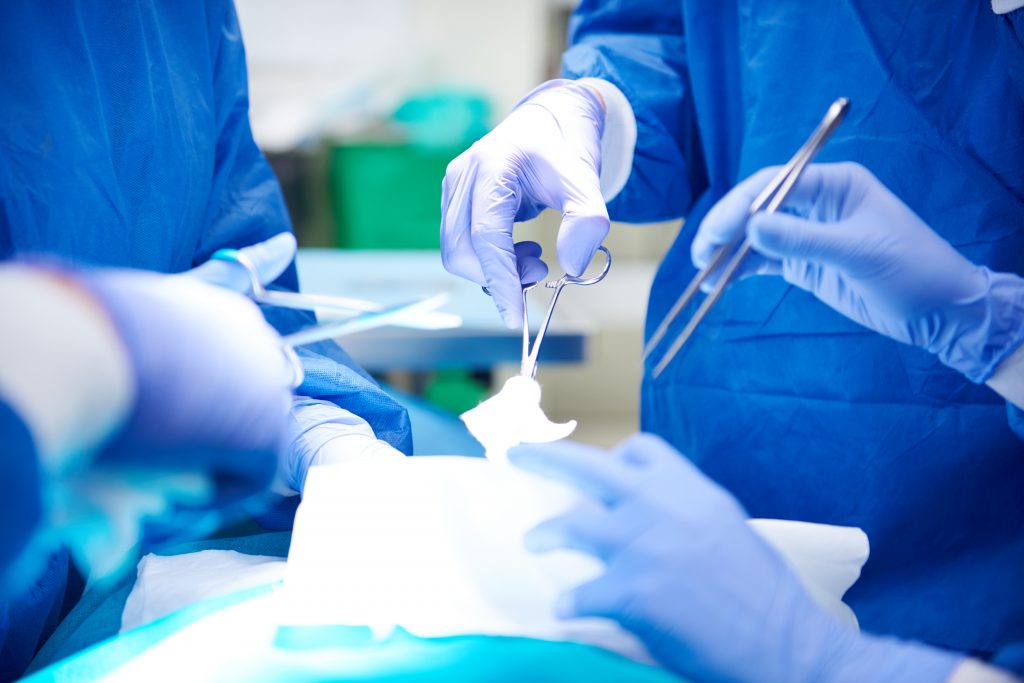Lumbar Radiculopathy

Radiculopathy in the Lumbar Region
Lumbar Radiculopathy is a condition that occurs when one of the nerves in the lumbar region of the spine, which is located in your lower back, has been pinched.
Lumbar Radiculopathy (regularly known as Sciatica) alludes to manifestations of pain, tingling sensations or numbness from the lower back and into the leg or perhaps down to the foot. The sciatic nerve is the biggest nerve in the body and leaves the spinal cord as a few nerves attach which join to frame the sciatic nerve. The nerve and pain that emanates from the lower back to behind the thigh and regularly beneath the knee to the lower leg or foot.

Sciatica is not in itself a sickness. In any case, the outcome is a procedure like a disc degeneration or herniation that specifically pushes on the nerve or the substance of the disc is causing an aggravation to the nerve. Any discomfort or irritation of a nerve coming about because of disc herniation is known as a Radiculopathy. Notwithstanding disc herniation, the sciatic nerve may end up plainly bothered by adjoining structures, which incorporate bone, muscle, tumors, contaminations, damage, and death. However, the most well-known reason for sciatica is a disc herniation.
The discs of the spine are made out of an internal gelatin-like center and a firm external ring. As the disc wears, it debilitates, and the internal center will project outward through the external ring. The subsequent weight of the nerve roots leaving the spinal section is strengthened by aggravation caused by harmed tissue.
Sciatica may happen because of degenerative disc infection, joint inflammation of the lumbar region, and through injury or damage to the lumbar region. It is frequently analyzed by history and side effects, which incorporate pain, consuming, tingling or numbness that emanates from the lower back and buttocks around the back of the thigh to cause low back pain, buttock pain, leg pain, or, most usually, hip pain.
Reasons
Lumbar Radiculopathy is caused by the inflammation of a nerve. The most common cause of Lumbar Radiculopathy is disc herniation. Vertebral discs are the soft cushions between the bones of your spine which act like shock absorbers. As aging occurs, these become dry and their edges may fracture or tear. If the center of the disc spills out, it can cause Lumbar Radiculopathy.
Another cause of Lumbar Radiculopathy may be spinal stenosis. This can be caused by the formation of extra bone or other conditions. These pinch the nerves or the spinal cord, leading to Lumbar Radiculopathy.
Radiculopathy happens when a nerve is packed by encompassing tissue. It's occasionally caused by a herniated spinal disc. This begins with a debilitating or tearing of the external edge of the disc. The core, or inward part, at that point, push outward and applies weight to an adjacent spinal nerve.
Bone spurs can likewise cause Radiculopathy. This is when additional bone structures on part of the spine. Bone spurs can create in view of injury or osteoarthritis. These spurs can solidify the spine and restricted the space where nerves are found, making them be compacted.
Radiculopathy may come about because of maturing or injury.
Radiculopathy is caused by pressure or aggravation of the nerves as they leave the spine. This can cause pressure on the nerve by a disc herniation, a bone spur (osteophytes) from osteoarthritis, or from thickening of encompassing tendons.
- - A variety of reasons for the pressure on the nerves range from a tumor or a multitude of diseases. Both of these can diminish the about of space in the spinal channel and compress the leaving nerve.
- - Scoliosis can cause the nerves on one side of the spine to end up noticeably compacted by the strange bend of the spine.
- - Aggravation of injury or degeneration can prompt Radiculopathy because of the bothering of the nerves.
Prevalence
Lumbar Radiculopathy affects both men and women. In the United States, it affects men earlier in life than women. Women don't tend to develop lumbar radiculopathy until they are in their 50's or 60's, while me most commonly affected in their 40's. Typically, symptoms of the disorder last from 45 to 60 days.
Risk Factors
Numerous spinal changes occur as you age. Radiculopathy generally influences individuals between the ages of 30 and 50.
Conditions like osteoarthritis, rheumatoid joint inflammation, and weight can build the danger of radiculopathy. Other hazard factors are poor stance, spinal variations from the norm like scoliosis, and tedious developments. Women that are pregnant have a higher risk. It can likewise be innate, so you are at expanded risk if your family has a history filled with radiculopathy.
Radiculopathy FAQ: Restrictions, Possibilities, and Commonalities

Symptoms of Radicular Radiculopathy
Lumbar Radiculopathy symptoms fluctuate depending on the particular nerve roots influenced. The most widely recognized manifestations are numbness, tingling, and weakness in the legs. This indicates that the nerve roots along the spinal cord are influenced. Occasionally the skin might be unusually sensitive to the touch. Assuming any of these side effects are evident, counseling a doctor for a precise conclusion is suggested.
The most widely recognized Lumbar Radiculopathy symptom is sciatica. Sciatica pain normally transmits from the back to the buttocks, and occasionally down to the feet. Tactile side effects are more typical in Radiculopathy.

Manifestations change contingent upon which kind of Radiculopathy you have. The side effects may influence distinctive areas of your back, arms, and legs, and can include:
- - a sharp pain that may intensify with specific activities
- - a shooting pain
- - numbness
- - tingling sensations
- - change or loss of reflexes
Lumbar Radiculopathy symptom includes almost constant pain that travels from the lower back into the backs of the upper thighs and, in some people, the pain continues all the way to the foot. This pain is usually sharp and is worse when you stand, walk and sit. Other Lumbar Radiculopathy symptoms are muscle weakness and decreased reflexes. If Lumbar Radiculopathy symptoms involve the nerves in the upper part of the lumbar spine, pain occurs in the front part of the leg and in the shins.
Diagnostic procedures
To diagnose Lumbar Radiculopathy symptoms, you will be asked about your symptoms and be given an examination. Your physician will assess your balance, strength, reflexes, how you walk and other symptoms related to your spine. Your doctor might recommend X-rays or a magnetic resonance imaging study (MRI) if Lumbar Radiculopathy is suspected. An MRI takes pictures of the soft tissues, like the nerves and spinal cord. It can provide information about whether the nerve roots or spinal cord are being compressed to confirm a diagnosis of Lumbar Radiculopathy symptoms.
The conclusion of Lumbar Radiculopathy symptoms starts with a restorative history and physical examination by the doctor. Amid the restorative history, the specialist will make inquiries about the sort and area of side effects, to what extent they have been available, what aggravates them more, and what other back issues may be present. By knowing the correct area of the patient's side effects, the specialist can help confine the nerve that is mindful. The physical examination will concentrate on the furthest point included. The specialist will check the patient's muscle quality, sensation and reflexes to check whether there are any anomalies.
The patient may then be made a request to get imaging concentrates to search for a wellspring of the radiculopathy. Plain x-rays are regularly acquired first. These can frequently recognize the nearness of injury or osteoarthritis and early indications of tumor or contamination. An MRI output may then be gotten. This examination gives the best take a gander at the delicate tissues around the spine including the nerves, the circle, and the tendons. On the off chance that the patient can't get an MRI, they may acquire a CT scan rather investigate conceivable pressure of the nerves.
Now and again the specialist may arrange a nerve conduction study or electromyogram (EMG). These examinations take a gander at the electrical activity along the nerve and can appear if there is harm to the nerve.
Many individuals with Lumbar Radiculopathy symptoms will look for therapeutic treatment for an essential end to the pain. The doctor will start with an intensive history of the patient and physical exam. Once the doctor recognizes the correct area of the manifestations, they can determine which nerves are causing the condition. Tests requested may include:
- X-ray: An x-ray can demonstrate the nearness and reason for injury, including herniated plates, osteoarthritis, and different causes.
- Magnetic Resonance Imaging (MRI): An MRI utilizes attractive fields and radio-recurrence waves to make a picture of the spine, and can uncover fine subtle elements of the spine, including tumors, nerves, and any harm to the spine. An MRI output can demonstrate subtle elements in the spine that can't ordinarily be seen on an x-ray. Here and there a complexity operator is infused into a vein in the hand or arm amid the test, which features certain tissues and structures to make points of interest much clearer. In instances of radiculopathy, the influenced nerves will be uncovered.
- Computerized Tomography (CT) scan is a noninvasive strategy that utilizations x-rays to create a three-dimensional picture of the spine. CT demonstrates more detail than an X-ray and is now and again utilized as a part of the expansion to an MRI to uncover pressure on the nerves.
Lumbar Radiculopathy Treatment
Nonsurgical procedures are usually recommended first for Lumbar Radiculopathy treatment. Common Lumbar Radiculopathy treatment usually includes pain medications, physical therapy and possibly steroid injections.
If symptoms don't improve within 2 months, or Lumbar Radiculopathy worsens, a doctor may recommend surgery a Lumbar Radiculopathy treatment option.
If Lumbar Radiculopathy includes muscle weakness or other severely debilitating problems, physicians may recommend surgery right away, instead of trying conservative Lumbar Radiculopathy treatment.
Luckily, the vast majority can get great alleviation of their indications of Radiculopathy with conservative Lumbar Radiculopathy treatment. This may incorporate calming drugs, non-intrusive treatment or chiropractic treatment, and refraining from the action that strains the neck or back. The dominant part of Radiculopathy patients react well to this preservationist treatment, and symptoms frequently improve within 6 to 12 weeks.
In the event that patients don't improve with the Lumbar Radiculopathy treatment described above, they may profit by an epidural steroid infusion. With the assistance of an X-ray machine, a doctor infuses steroid solution between the bones of the spine nearby the included nerves. This can help to quickly decrease the aggravation and disturbance of the nerve and help lessen the manifestations of Radiculopathy.
Sometimes the side effects proceed notwithstanding the majority of the above Lumbar Radiculopathy treatment alternatives. In the event that this happens and the side effects are serious, surgery might be an alternative. The objective of the surgery is to relieve the pressure from the influenced nerve. Contingent upon the reason for the Radiculopathy, this should be possible by a Laminectomy or a Discectomy. A Laminectomy extracts a small portion of the bone covering the nerve to enable it to have extra space. A Discectomy extracts the segment of the circle that has herniated out and is compressing a nerve.
Your specialist may prescribe home care, pharmaceuticals, surgery, or a blend of medications.
Home care
You should restrict exercises that irritate your pain. Your specialist can recommend a support, prop, or delicate neck brace to immobilize the influenced range. This makes it simpler for you to rest the injured area.
Occasionally bed rest, footing or medications with are alternatives your specialist may recommend. Footing includes the utilization of weights or other external devices to alleviate pressure on your spinal nerve by stretching the spine.
Your specialist may likewise suggest exercise based recuperation (PT). PT may incorporate hot and cool treatment and different medicines. Your advisors can show you approaches to reinforce, extend, and treat the influenced area.
For a few people, weight reduction may help decrease pressure on the influenced area.
Pharmaceuticals
A few pharmaceuticals can be powerful in Lumbar Radiculopathy treatment
- - analgesics
- - nonsteroidal calming medications, for example, ibuprofen (Advil) and naproxen (Aleve)
- - muscle relaxants
- - oral corticosteroids
- - solution opioids for serious pain
- - spinal corticosteroid infusions into the influenced zone
Non-Surgical Treatment
Many instances of radiculopathy can be dealt with effectively with traditional measures. These incorporate the utilization of over-the-counter pain relievers and against inflammatories, for example, acetaminophen, and ibuprofen, and steroid infusions, directed in a specialist's office. Oral cortisone when the pain is mild, or epidural infusions of corticosteroids when experiencing extreme pain, can be useful. The epidural attempts to soothe aggravation and swelling of the herniated disc, therefore diminishing disturbance of the nerve.
Through a program of activity, calming and muscle relaxant pharmaceuticals, and time, most patients have an improvement in their pain.
Numerous patients that experience pain when sitting gain some relief of pain by resting flat or walking/standing. Bed rest has customarily been the prescribed treatment for sciatica. In any case, a study announced in the New England Journal of Medicine uncovered that there was no distinction inadequacy between patients with sciatica treated with bed rest or with "careful holding up."
In 95% of cases, these basic medicines are viable. For the remaining 5%, the intense pain caused by compressed nerves and nerve damage requires more forceful medicines.
Surgery
Your specialist may suggest surgery if your condition doesn't enhance within a predefined period. This is regularly after around 6 to 12 weeks of prior treatment. They may likewise recommend surgery if numerous nerves are damaged or the nerve is continuing regardless of treatment.

Surgery can relieve the influenced nerve from the pressure. One method is known as a Discectomy. This includes extracting bone goads or part of a herniated plate. Amid this strategy, a segment of your vertebrae may be expelled or intertwined.
Similarly, as with any surgery, there are dangers like diseases, complications from anesthesia and even death.
Prevention
There is no known way to prevent Lumbar Radiculopathy but to keep your back healthy, maintain a healthy weight, practice good posture and work some weight-bearing exercise such as walking into your daily routine.






